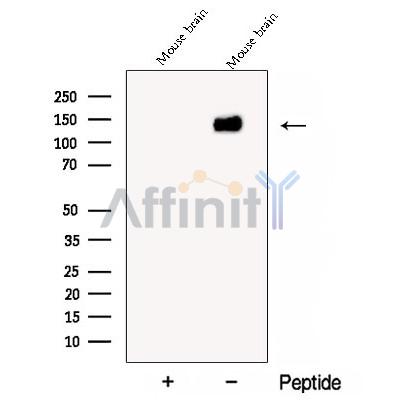CYFIP2 Antibody - #DF12927
| Product: | CYFIP2 Antibody |
| Catalog: | DF12927 |
| Description: | Rabbit polyclonal antibody to CYFIP2 |
| Application: | WB |
| Reactivity: | Human, Mouse, Monkey |
| Prediction: | Pig, Zebrafish, Bovine, Horse, Sheep, Rabbit, Dog, Chicken, Xenopus |
| Mol.Wt.: | 130 kDa; 148kD(Calculated). |
| Uniprot: | Q96F07 |
| RRID: | AB_2845888 |
Related Downloads
Protocols
Product Info
*The optimal dilutions should be determined by the end user. For optimal experimental results, antibody reuse is not recommended.
*Tips:
WB: For western blot detection of denatured protein samples. IHC: For immunohistochemical detection of paraffin sections (IHC-p) or frozen sections (IHC-f) of tissue samples. IF/ICC: For immunofluorescence detection of cell samples. ELISA(peptide): For ELISA detection of antigenic peptide.
Cite Format: Affinity Biosciences Cat# DF12927, RRID:AB_2845888.
Fold/Unfold
CYFP2; cytoplasmic FMR1 interacting protein 2; KIAA1168; p53 inducible protein; p53-inducible protein 121; PIR121;
Immunogens
A synthesized peptide derived from human CYFIP2, corresponding to a region within the internal amino acids.
Expressed in T-cells. Increased expression is observed in CD4(+) T-lymphocytes from patients with multiple sclerosis (at protein level).
- Q96F07 CYFP2_HUMAN:
- Protein BLAST With
- NCBI/
- ExPASy/
- Uniprot
MTTHVTLEDALSNVDLLEELPLPDQQPCIEPPPSSIMYQANFDTNFEDRNAFVTGIARYIEQATVHSSMNEMLEEGHEYAVMLYTWRSCSRAIPQVKCNEQPNRVEIYEKTVEVLEPEVTKLMKFMYFQRKAIERFCSEVKRLCHAERRKDFVSEAYLLTLGKFINMFAVLDELKNMKCSVKNDHSAYKRAAQFLRKMADPQSIQESQNLSMFLANHNRITQCLHQQLEVIPGYEELLADIVNICVDYYENKMYLTPSEKHMLLKVMGFGLYLMDGNVSNIYKLDAKKRINLSKIDKFFKQLQVVPLFGDMQIELARYIKTSAHYEENKSKWTCTQSSISPQYNICEQMVQIRDDHIRFISELARYSNSEVVTGSGLDSQKSDEEYRELFDLALRGLQLLSKWSAHVMEVYSWKLVHPTDKFCNKDCPGTAEEYERATRYNYTSEEKFAFVEVIAMIKGLQVLMGRMESVFNQAIRNTIYAALQDFAQVTLREPLRQAVRKKKNVLISVLQAIRKTICDWEGGREPPNDPCLRGEKDPKGGFDIKVPRRAVGPSSTQACQWSPRALFHPTGGTQGRRGCRSLLYMVRTMLESLIADKSGSKKTLRSSLDGPIVLAIEDFHKQSFFFTHLLNISEALQQCCDLSQLWFREFFLELTMGRRIQFPIEMSMPWILTDHILETKEPSMMEYVLYPLDLYNDSAYYALTKFKKQFLYDEIEAEVNLCFDQFVYKLADQIFAYYKAMAGSVLLDKRFRAECKNYGVIIPYPPSNRYETLLKQRHVQLLGRSIDLNRLITQRISAAMYKSLDQAISRFESEDLTSIVELEWLLEINRLTHRLLCKHMTLDSFDAMFREANHNVSAPYGRITLHVFWELNFDFLPNYCYNGSTNRFVRTAIPFTQEPQRDKPANVQPYYLYGSKPLNIAYSHIYSSYRNFVGPPHFKTICRLLGYQGIAVVMEELLKIVKSLLQGTILQYVKTLIEVMPKICRLPRHEYGSPGILEFFHHQLKDIIEYAELKTDVFQSLREVGNAILFCLLIEQALSQEEVCDLLHAAPFQNILPRVYIKEGERLEVRMKRLEAKYAPLHLVPLIERLGTPQQIAIAREGDLLTKERLCCGLSMFEVILTRIRSYLQDPIWRGPPPTNGVMHVDECVEFHRLWSAMQFVYCIPVGTNEFTAEQCFGDGLNWAGCSIIVLLGQQRRFDLFDFCYHLLKVQRQDGKDEIIKNVPLKKMADRIRKYQILNNEVFAILNKYMKSVETDSSTVEHVRCFQPPIHQSLATTC
Predictions
Score>80(red) has high confidence and is suggested to be used for WB detection. *The prediction model is mainly based on the alignment of immunogen sequences, the results are for reference only, not as the basis of quality assurance.
High(score>80) Medium(80>score>50) Low(score<50) No confidence
Research Backgrounds
Involved in T-cell adhesion and p53/TP53-dependent induction of apoptosis. Does not bind RNA. As component of the WAVE1 complex, required for BDNF-NTRK2 endocytic trafficking and signaling from early endosomes (By similarity).
Cytoplasm. Nucleus. Cytoplasm>Perinuclear region. Cell junction>Synapse>Synaptosome.
Note: Highly expressed in the perinuclear regionand enriched in synaptosomes (By similarity). Treatment with leptomycin-B triggers translocation to the nucleus (PubMed:17245118).
Expressed in T-cells. Increased expression is observed in CD4(+) T-lymphocytes from patients with multiple sclerosis (at protein level).
Belongs to the CYFIP family.
Research Fields
· Cellular Processes > Cell motility > Regulation of actin cytoskeleton. (View pathway)
· Genetic Information Processing > Translation > RNA transport.
Restrictive clause
Affinity Biosciences tests all products strictly. Citations are provided as a resource for additional applications that have not been validated by Affinity Biosciences. Please choose the appropriate format for each application and consult Materials and Methods sections for additional details about the use of any product in these publications.
For Research Use Only.
Not for use in diagnostic or therapeutic procedures. Not for resale. Not for distribution without written consent. Affinity Biosciences will not be held responsible for patent infringement or other violations that may occur with the use of our products. Affinity Biosciences, Affinity Biosciences Logo and all other trademarks are the property of Affinity Biosciences LTD.

